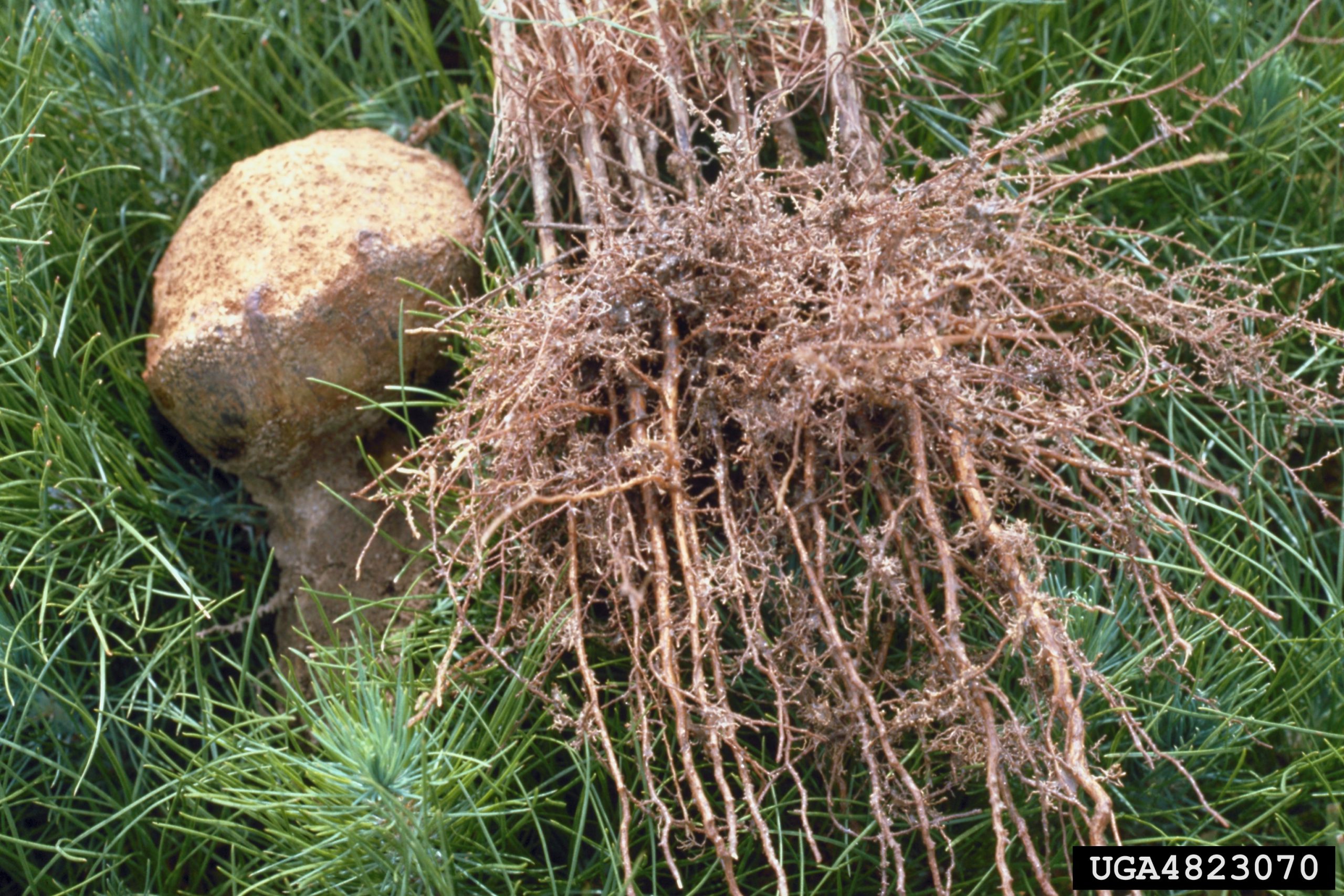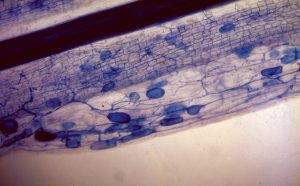
Mycorrhizal fungi develop mutually beneficial symbiotic relationships with plant roots. Photo by Edward L. Barnard, Florida Department of Agriculture and Consumer Services, Bugwood.org.
If you have taken an elementary school science class, you have probably learned the basics of photosynthesis. In case you are a bit rusty, photosynthesis is the process by which plants capture sunlight to manufacture their food. They absorb carbon dioxide from the atmosphere and water from the soil. With these ingredients, they create carbohydrates, or sugars, that supply the energy to grow and develop.
As you can imagine, this energy is vital to the health of the plant. But fascinatingly, plants expel between 20 and 40 percent of these sugars from their roots into the surrounding area around the roots. The sugars that the plant releases, along with amino acids, organic acids, enzymes, and other substances, are called root exudates. The area just inside the root where the sugars are released, and the area just outside the root where the sugars end up, is called the rhizosphere.
But why would a plant waste this energy? This is because they derive benefits from the unique microbial population that inhabits the rhizosphere. Plant roots are limited by the amount of nutrients they can take up in the soil. By feeding microorganisms their sugars, they are essentially recruiting workers to help them scavenge for nutrients in areas that they cannot access on their own.

A microscopic image of mycorrhizal fungi in black walnut. Photo by Robert L. Anderson, USDA Forest Service, Bugwood.org.
Bacterial colonies, which are types of microorganisms, establish themselves within the rhizosphere and feed on the root exudates, allowing the bacteria to multiply. Along with the sugars they take in from the root exudates, they also take in nutrients from the soil. The waste that is produced by the bacteria is rich in bioavailable plant nutrients, which the plant then uses, creating a plant-microbe symbiotic relationship where everyone wins.
Another type of specialized microorganism, mycorrhizal fungi, also develops a symbiotic relationship with plants. Its meaning is within its name, as “myco” literally means fungus and “rhiza” literally means root. There are an estimated 50,000 fungal species that form these beneficial relationships with approximately 95 percent of plant families.
The mycorrhizal fungal hyphae, which are tiny fungal filaments one cell thick, do not have chlorophyll and are therefore not able to photosynthesize. Instead, the fungal networks have a large surface area that allows them to be particularly good at extracting nutrients from the soil. This enables them to access nutrients that plant roots would not be able to access on their own. The fungi drill into the plant root and trade these nutrients, along with water, with the plant in exchange for the sugary root exudates. In this way, both the fungi and the plant benefit from the relationship. Interestingly, these types of relationships will only develop once the plant releases particular root exudates that attract the microorganisms they are seeking. In essence, the mycorrhizal fungal hyphae will not associate with the root until they are invited.
Along with root exudates, root hairs and other plant cells accumulate within the rhizosphere as they grow and die throughout the plant’s life cycle. The combination of the root exudates, dead root hairs, and dead plant cells creates essentially a compost pile within the rhizosphere. This combination of substances establishes an environment where beneficial microorganisms can thrive, and a plant can maximize its nutrient uptake capacity.
Amazingly, there can be up to a billion bacteria and several yards of fungal hyphae living in just one teaspoon of soil! Of course, not all microorganisms are beneficial to the plant. But remarkably, plants have developed many ways in which they benefit, and ultimately thrive, in this diverse soil ecosystem.
As humans, we continue to learn more and more about these complicated and interesting interactions taking place in the soil beneath us. And the more we learn, the more we discover just how important these diverse ecosystems are to the health of the food web, and therefore, to the health of our planet as a whole.
- Dung Beetles of the Florida Panhandle - June 26, 2025
- Summer Veggies That Can Take The Heat - May 15, 2025
- Stopping Tomato Blossom-End Rot Before It Starts - April 3, 2025
